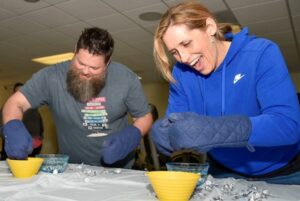
Story by Douglas Stutz
Naval Hospital Bremerton/Navy Medicine Readiness and Training Command Bremerton
A hypothetical scenario involving injuries to sight, sinew and senses was presented to Naval Hospital Bremerton’s Physical Therapy department team.
An industrial accident caused eyesight injury, along with shoulder, wrist and hand damage. There’s chemical burns, sprains and strains.
After seeking immediate medical care, every body part associated with the accident still hurts, including having to deal with temporary blindness. The pain is as much mental and emotional as it is physical.
“It’s OT time,” exclaimed Ms. Teri Nyblom, NHB certified occupational therapist assistant.
From grip strengthening to vision restoration, Nyblom presented her Physical Therapy counterparts with practical, hands-on instruction of what occupational therapists offer any eligible beneficiaries during their recovering, recuperating and rehabilitating process.
With April designated as Occupational Therapy Month, Nyblom took the timely opportunity to showcase how she uses a holistic approach to help treat physical, psychological, and even emotional injuries.
“We deal with a lot of repetitive motion injuries and such conditions as post-surgical rehabilitation by combining ultrasound, massage, teaching and training to heal. Healing can be hard. For example, scarring can prevent range of motion. Our goal is to help a patient recover their normal range of motion,” Nyblom said.
There is a difference between occupational therapy and physical therapy. Nyblom stressed that occupational therapy promotes health by enabling individuals to achieve independence and improve their ability to perform meaningful and purposeful daily activities across their lifespan.
Physical Therapy, although somewhat similar, primarily focuses on remediation – fixing – impairment(s) and/or disabilities and the promotion of a patient’s physical mobility, movement, and ability to function.
There is an overlap between the two disciplines as both Occupational Therapy – with over 1,610 patients seen last year – and Physical Therapy – with over 9,200 patients seen last year – focus on injury recovery and educating their patients towards that goal.
Occupational therapists also work with patients who have had a stroke, traumatic brain injury, spinal cord injury, need in-home therapy and help with debilitating low vision issues such as glaucoma, a major eye disease than can lead to disability.
Nyblom began her interactive presentation by dealing with temporary blindness. Her physical therapy team participants were blindfolded to simulate bandaged eyes, followed by given therapeutic instructions on orientation, mobility and visual strengthening exercises. Their task was a blind drawing game. On a blank sheet of paper, they were told to draw an island. More detailed directions followed to test eye-to-hand coordination as well as memorization. To the left of the island, they were told add a ship, include some fish in the sea, and put a palm tree on the island. More of the same followed.
“You can only see shadows at this point,” instructs Nyblom. “But you are given a task in fine motor coordination and kinesthesia. Kinesthesia sensation involves feeling the movement of limbs and joints. Such examples are walking without looking at one’s feet, typing without looking at one’s hands or moving limbs with one’s eyes closed.”
The individual exercise gave way to teamwork drills to focus on other added injury concerns as FOOSH – acronym for ‘fell on outstretched hand’ – increase range of motion, improve fine motor skills and continue nerve regeneration.
Some of the most regular injuries seen by the Occupational Therapy clinic tend to be associated with the wrist, hand and forearm such as lacerated tendon(s) on a finger(s), tendinitis – inflammation – fractures and carpal tunnel syndrome.
“We see a ton of lateral epicondylitis and medial epicondylitis – more commonly known as tennis elbow and golfer’s elbow. Both injuries are caused by overuse,” remarked Nyblom.
Occupational therapists also treat such diagnoses as arthritis, autism, Post-Traumatic Stress Disorder (PTSD), depression, Parkinson’s disease, muscular dystrophy, complex regional pain syndrome, multiple sclerosis, cerebral palsy, neuropathy, microcephaly, amyotrophic lateral sclerosis (ALS), and Huntington’s disease.
“We help our patients overcome all their injuries and deficits to be fully functional,” Nyblom stated.